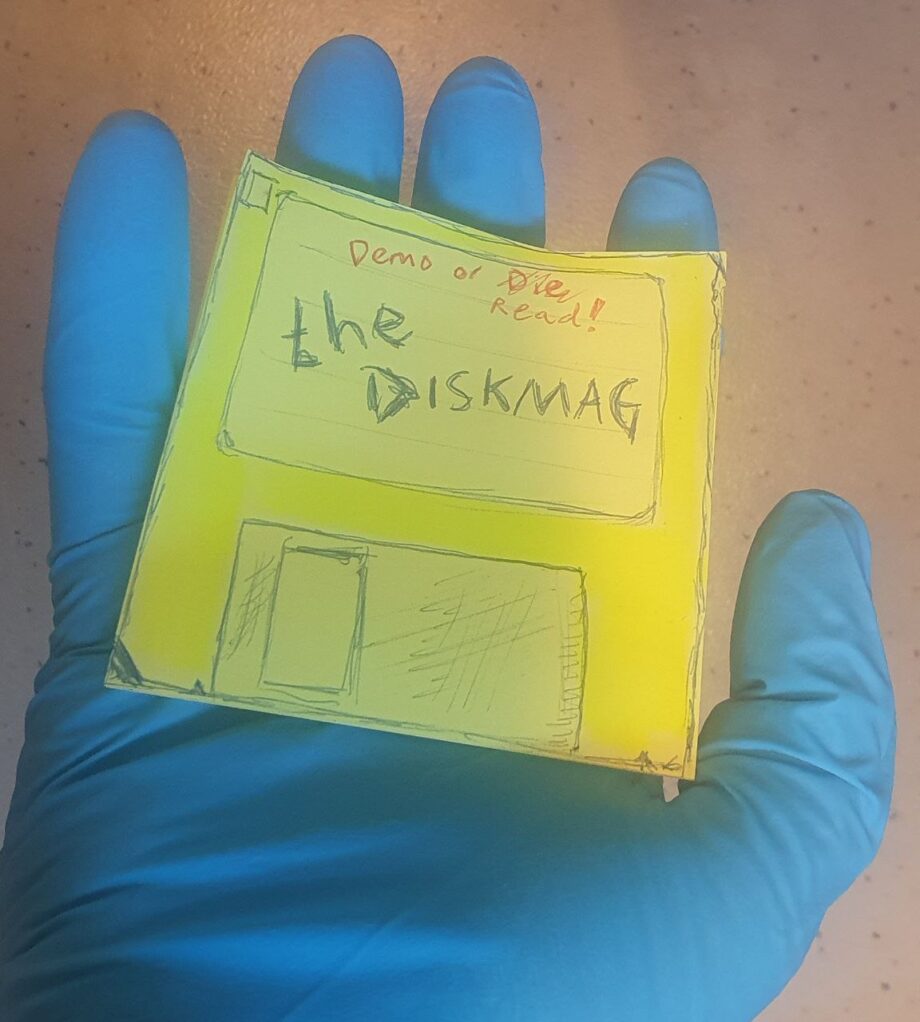text by Adok / Hugi.
Now in 2025, I am a middle-aged man who spends much of his spare time on Facebook, communicating with a few selected people from all over the world.
Read or Die! Picture with the drawn floppy disc by Browallia.
To understand what was really magical about the demoscene, we have to look back to the times when we were far younger and Facebook did not exist yet.
The magic of the demoscene was that the demoscene was a self-organized community of young people. Back in the 1990s, most of us were living together with our parents and attending school. Our lives were shaped by the influence of grown-ups far older than ourselves. We had to follow their orders and comply with what they demanded from us. Everything was organized by the government and its institutions. For many of us computers were the last resort that really left us freedom to do whatever we wanted to. And now, a community of like-minded people, not lamers like most of our classmates but people who actually had a clue about computers, emerged, which was organized by people our age or only a little older than ourselves. We communicated via snailmail, diskmags, bulletin-board systems, and occasionally met at parties (if our parents allowed us to). There was no government institution to tell us what to do and what not to do. Everything was self-organized. The people who led the demogroups were kids like us. Also, there were no laws. All rules were informal and we agreed on them by custom.
Sure, demos are fascinating, and many people became interested in the demoscene because of the aesthetics of computer demos. But there are also a lot of sceners to whom the scene itself appealed. I recall for example Scamp having written his thoughts about the scene in old diskmags, which he later denounced as being “childish”. Also, there was a computer scene in a broader sense which was not only about demos. This scene was present in the German language diskmags for PC, for instance. The people involved in it also considered themselves sceners although they were not involved in the making of demos. This computer scene in a broader sense had very much in common with the demoscene as we know it.
Nowadays we have Demozoo and Pouet. Everybody can access these websites if he/she only knows what to look for. So the demoscene is no longer “underground”. The “underground” aspect however was an important aspect of the scene in the past. The scene was not easy to spot for outsiders. You had to make an effort to discover it. And then, you would not talk about it to any random lamer. Many sceners, such as Smash, felt like being part of a “secret society” or a conspiracy. That was another aspect the essence of which cannot be overstated.
We must not forget either that computers were not so common before the turn of the century. Those who owned a home computer were already part of a small-ish “elite”. That also contributed to the spirit of the scene: the feeling to be part of an “elite”.
In any case, the world has changed dramatically since the 1990s. Nowadays virtually everbody in the developed world has a computer and Internet access, and the social media have changed the whole of society very much. It has become easy to get in contact with other people of interest, but it also has become easy for the government to eavesdrop on us. To be honest, I have no idea if the online communities that have meanwhile emerged are remotely as magical as the demoscene once was.
Adok / Hugi
What do you think about this? Please leave a comment below this article!
the Diskmag
The one and only!
Submit your own article, or contact nukleUS!
Back to the Diskmag #1 (online), Back to the Diskmag (overview), back to Diskmags (main)
Amiga online magazines (home), Nukleus.

Bombe asked: whats the point of Adok’s article?
That’s like asking what’s the point of a Melon demo. 😉